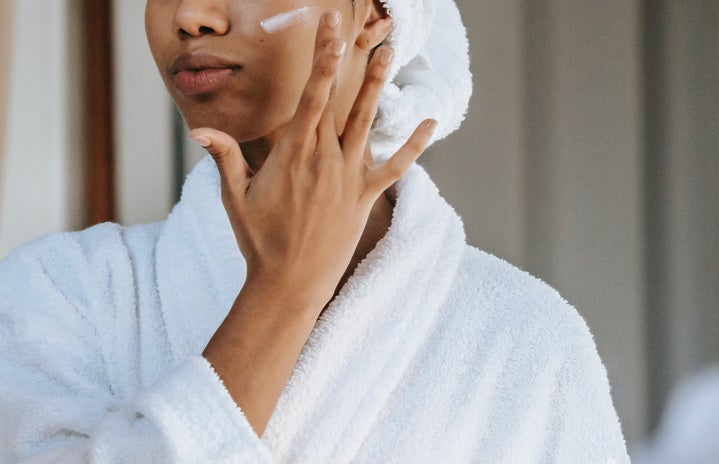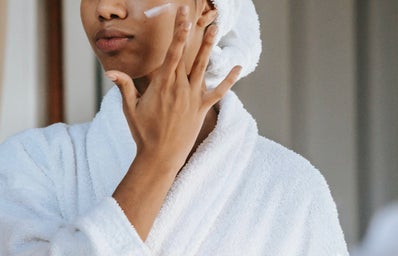In recent years, there has been a massive boom in the skincare industry, which has led to hundreds of new brands and thousands of new products across the globe. This understandably makes it difficult to find the right skincare products for the individual, especially those of us with sensitive or acne-prone skin. Rather than just giving you products that worked for my skin, this article will provide ingredients to look for on the label that have been shown to benefit people with acne-prone skin. Although this list is nonexhaustive, the ingredients I chose are easily accessible at a variety of price points and products.
Alpha-hydroxy acids (AHAs)
Alpha-hydroxy acids are commonly found in anti-aging products and clinical strength chemical peels. There are seven common types of alpha-hydroxy acids found in skincare which you can see here, but they are often marketed in skincare as just AHAs. AHAs can be found in both over-the-counter and prescription products. AHAs are an exfoliant, which means that they work to remove the layer of dead skin cells from your face, leaving your skin brighter and smoother. Exfoliation also helps to prevent clogged pores, a common cause of acne. You should only use AHAs once every other day at most, and if you have sensitive skin, you should make sure to do a patch test before using it.
Benzoyl peroxide
Benzoyl peroxide is usually found in products used to treat mild to moderate acne. It is also sometimes used alongside stronger acne treatments to get better and more long term results. Benzoyl peroxide is most often found over-the-counter, and is usually an inexpensive ingredient. Benzoyl peroxide is used for its antibacterial properties, meaning that it targets and kills acne-causing bacteria on your face and body. In higher concentrations, it can also have an exfoliating and even peeling effect, which can be used to remove acne scars and hyperpigmentations, as well as active acne. The downside to benzoyl peroxide is that a handful of people are allergic to it, so you should always do a 48-hour patch test before using it on your face. If you experience any sort of itching and burning, make sure to remove the product with water immediately. For more about symptoms of an allergic reaction, read this WebMD article.
Niacinamide
Niacinamide is a form of B3 and can be used orally or topically for varying benefits. In skincare, niacinamide is usually found in serums and sunscreens. It is a newer product in the skincare world, but is still heavily researched and tested. Niacinamide is usually found in over-the-counter products, but is also often recommended by dermatologists and estheticians. Benefits you might see from incorporating niacinamide into your routine include reduced inflammation, regulated oil production, improved skin texture and even pore reduction. Although niacinamide is not too hard on the skin, you should start with a concentration of less than five percent if you have experienced sensitivity in the past. Learn more about the benefits of niacinamide in skincare here.
Retinol
In contrast to niacinamide, retinol or retinoids are nothing new to skincare, although they have recently gained popularity for their benefits at a variety of potencies. Retinol can be found in both over-the-counter and prescription products, and is usually considered an anti-aging ingredient. It is usually found in serums and lotions. Retinoids work by affecting gene expression, which helps prevent new or worsening acne while treating imperfections on the skin, including acne, fine lines and wrinkles, and hyperpigmentation. Although it is not an exfoliant, it usually leaves the skin looking brighter and smoother, much like an exfoliating product does. Retinol has been shown to be harmful to sensitive skin in higher concentrations, so starting with a low concentration every two to three days and working your way up to higher concentrations works best. If you experience any form of irritation, you should remove the product immediately and talk with your dermatologist. For a variety of retinoid products at varying concentrations, check out this Allure article!
Salicylic acid (BHA)
Salicylic acid, also referred to as BHA, is an acne-treating ingredient as well as an exfoliant. It is almost always found in over-the-counter products, but can also be recommended by dermatologists. It is found in wash-off treatments as well as spot treatments for acne. Salicylic acid works by penetrating the lipid barrier of your skin, essentially cleansing it from the inside out. It has been known to reduce the appearance of pimples overnight, as well as reduce irritation and sensitivity in wash-off treatments. Like retinol, salicylic acid can be found at a variety of concentrations, and it is best to start at a low concentration and work your way up in order to prevent irritation. You can find more information on how BHA works here.
Because we are all unique people, nobody’s skin needs are going to be exactly the same. While one product may work miracles for one person, it may not do anything for another. Everyone also has different budgets, time constraints and resources for skincare. That is why I hope by giving you ingredients rather than products, you will be able to find which products with these ingredients work best for your skin type. Wherever you go, however much you spend, and whatever you choose, I hope these ingredients help you get your skin to the best it can be!



